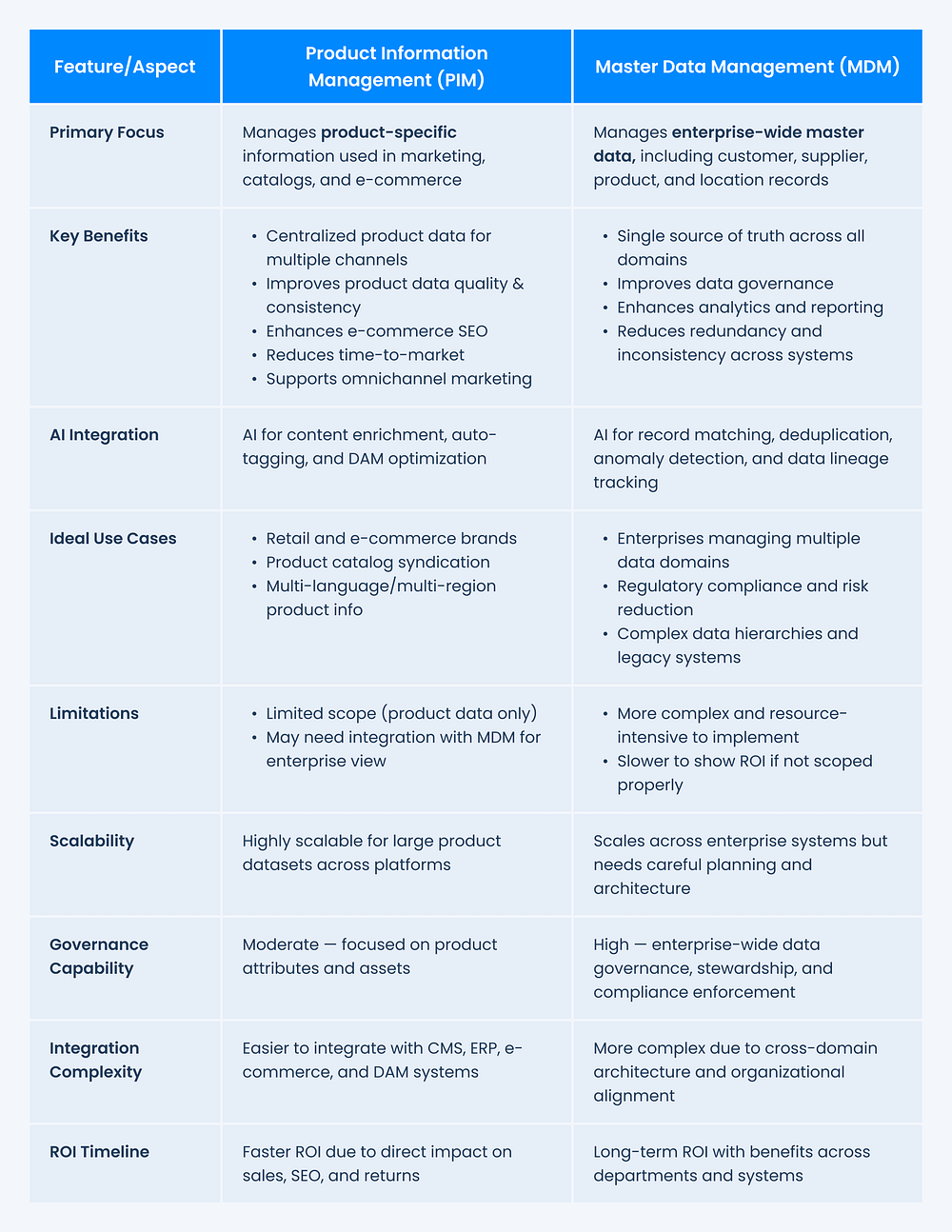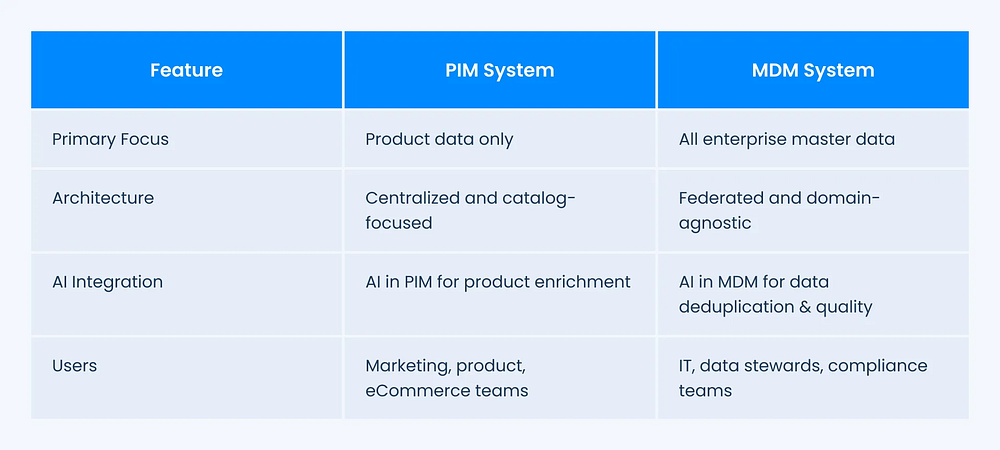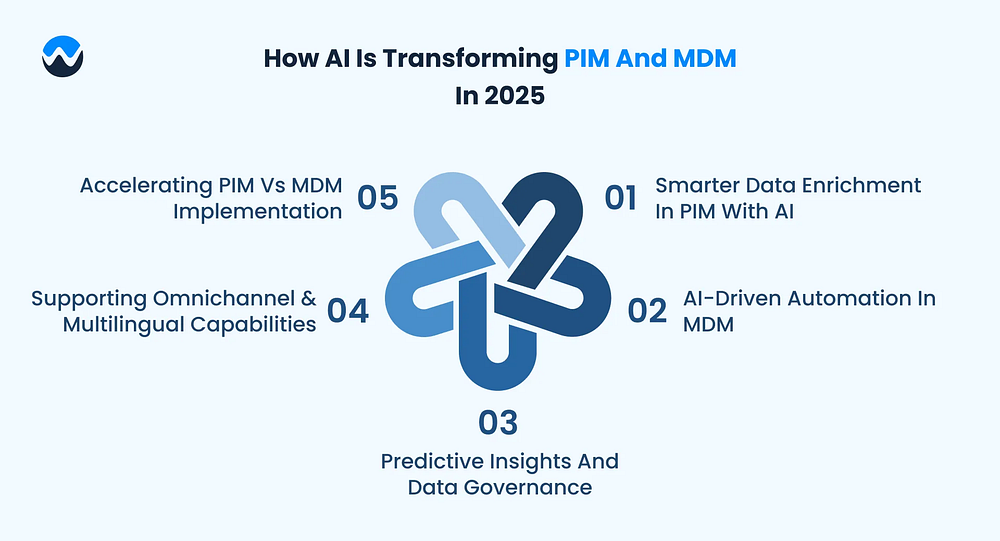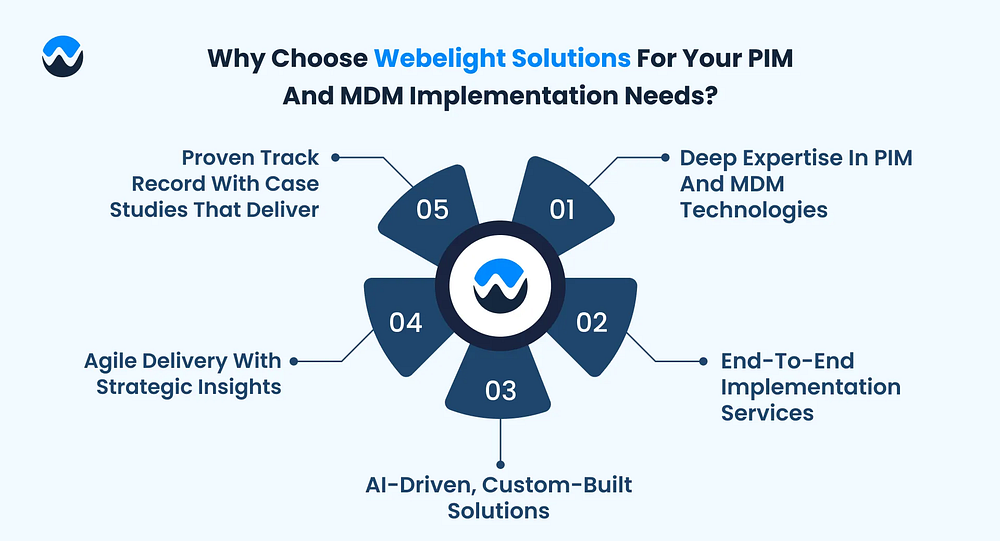PIM vs MDM Explained: Definitions, Use Cases, and Best Practices for 2025
Confused between PIM and MDM? Understand the differences, use cases & best practices for 2025 in our latest guide.

Choosing between Product Information Management (PIM) and Master Data Management (MDM) can be challenging — especially as both systems evolve rapidly with AI and data governance advancements in 2025. While they may sound similar, they serve distinct purposes in the data ecosystem. If you’re a business leader, IT strategist, or digital commerce decision-maker, understanding their unique benefits, limitations, and best-fit use cases is critical to making the right investment.
The table below gives you a quick side-by-side comparison of PIM vs MDM to help you get started:

What Is Product Information Management (PIM)? Definition, Benefits, and 2025 Insights
In today’s fast-paced digital economy, businesses are managing more product data than ever before. Whether you’re an online retailer, manufacturer, or distributor, the accuracy and consistency of your product information can make or break customer trust, operational efficiency, and sales growth. That’s where Product Information Management (PIM) comes in.

What Is Product Information Management (PIM)?
Product Information Management (PIM) refers to a centralized system or process designed to collect, manage, enrich, and distribute product data across multiple channels, platforms, and departments. It acts as the single source of truth for all product-related content — descriptions, specifications, pricing, images, videos, technical documents, and more.
Unlike a basic database, a PIM system enables structured workflows, automated data syndication, and seamless collaboration between teams — marketing, IT, product, and sales. This helps reduce manual errors and maintain product data governance across global catalogs and markets.
Why Is PIM So Relevant in 2025?
As product portfolios expand and customers demand hyper-personalized experiences across omnichannel platforms, managing product data manually or across disconnected systems is no longer sustainable. By 2025, more organizations are shifting toward AI-powered PIM solutions that not only centralize data but also optimize it using artificial intelligence and machine learning.
For instance:
-
AI in PIM helps with smart categorization, auto-tagging, attribute extraction, and content scoring.
-
PIM digital asset management (DAM) integrates rich media files with structured product data for better content syndication.
-
Businesses using centralized product data platforms report faster time-to-market, improved e-commerce SEO with PIM, and reduced product return rates.
According to recent industry data, companies adopting modern PIM implementation best practices in 2025 have seen a measurable improvement in:
-
Product listing accuracy (up to 95%)
-
Multichannel sales efficiency
-
Regulatory compliance and traceability
-
Customer satisfaction and brand consistency
PIM vs Traditional Product Data Management
Traditional systems like spreadsheets, ERPs, or CMS platforms often lack the agility and scalability required for high-volume, high-velocity product data environments. In contrast, a modern PIM system integrates with MDM solutions, eCommerce platforms, and ERPs to provide a 360° product data management framework that supports both back-office operations and customer-facing experiences.
The Strategic Role of PIM in Business Growth
Investing in a scalable, AI-enhanced PIM solution is no longer a “nice to have” — it’s a strategic necessity for businesses aiming to scale their catalog, expand globally, or implement a robust product master data management architecture.
From improving PIM digital asset optimization to enabling better decision-making with centralized product data, the benefits of PIM in 2025 are clear: operational efficiency, customer trust, and competitive advantage.

What Is Master Data Management (MDM)? Definition, Scope, and Benefits in 2025
In 2025, businesses are operating in an environment where data is both a strategic asset and a competitive differentiator. Amid this complexity, Master Data Management (MDM) emerges as a mission-critical discipline, empowering organizations to unify, govern, and leverage core data assets across systems, teams, and customer touchpoints.
What Is Master Data Management (MDM)?
Master Data Management (MDM) is a comprehensive framework that enables businesses to create a single, consistent, and trusted view of their critical data — such as customers, products, suppliers, locations, and assets. This unified dataset, often referred to as “master data,” forms the foundation for decision-making, digital transformation, compliance, and operational efficiency.
Unlike Product Information Management (PIM), which focuses specifically on product-related content, MDM systems span across all enterprise domains. MDM ensures that every system — ERP, CRM, marketing automation, logistics, finance — references the same accurate and up-to-date information.
The Scope of MDM: Beyond Product Data
In its broader scope, MDM solutions manage data domains including:
-
Product Master Data Management
-
Customer Master Data
-
Vendor and Supplier Data
-
Location and Asset Records
-
Employee and Financial Records
This breadth makes MDM indispensable for enterprises operating at scale or across multiple geographies and verticals. The difference between PIM and MDM lies in this scope — while PIM is a subset focused on product information, MDM provides a master architecture that connects all data points.
Data Governance and Regulatory Compliance in MDM
One of the primary drivers behind MDM adoption in 2025 is data governance. With increasing regulations (GDPR, HIPAA, SOC 2, etc.), businesses must ensure that their data is consistent, traceable, and secure.
MDM enables:
-
Robust product data governance frameworks
-
Version control and audit trails
-
Metadata standardization
-
Role-based access for data stewardship
In industries like healthcare, banking, and manufacturing, where regulatory compliance is non-negotiable, MDM solutions serve as the foundation for audit readiness and policy enforcement.
AI in MDM: The 2025 Advantage
With the rise of AI and automation, modern MDM systems now incorporate AI-powered data enrichment, anomaly detection, and real-time synchronization. These features dramatically reduce manual errors and ensure that decision-makers are working with clean, actionable data.
While AI in PIM focuses on optimizing product data, AI in MDM applies predictive analytics to identify duplication, suggest corrections, and improve data quality across enterprise systems.
Strategic Business Benefits of MDM in 2025
Implementing a modern MDM solution delivers far-reaching business outcomes:
-
Accelerated time-to-market for new products and services
-
Increased trust in analytics, reporting, and business intelligence
-
Seamless omnichannel experiences through centralized product data
-
Efficient product master data management across teams
-
Foundation for digital transformation and scalable growth
In 2025, businesses that invest in Master Data Management (MDM) aren’t just improving IT hygiene — they’re setting the stage for enterprise agility, innovation, and customer-centricity.

PIM vs MDM: Key Differences in Architecture, Data Control, and Use Cases
In 2025, selecting the right data management solution — Product Information Management vs Master Data Management — requires a clear understanding of how they differ in system architecture, data ownership, and enterprise use cases. Though both serve as data hubs, their scope, functionality, and purpose are distinct.
Architecture of PIM vs MDM: Centralized vs Federated Systems
PIM systems are purpose-built to manage and enrich product-related content. They typically operate as centralized product data platforms that aggregate product details from multiple sources — ERP, PLM, marketing tools — and enhance them for distribution across eCommerce channels, marketplaces, and catalogs.
In contrast, MDM solutions are often federated architectures that govern multiple data domains — customer, supplier, employee, product — across disparate systems. MDM integrates with every core application (CRM, ERP, SCM, BI) to ensure that all departments reference the same golden record.

Data Ownership and Control Comparison of PIM & MDM
PIM offers domain-level control — mainly for product content managers and marketing teams. It enables fast enrichment, localization, and omnichannel publishing with workflows tailored to product catalogs.
MDM, however, involves enterprise-wide governance. It includes strict data stewardship roles, cross-domain validation, and metadata versioning. This level of control is essential for regulated industries and businesses managing customer, financial, or supply chain data alongside products.
If your organization’s goal is to maintain product data governance for multichannel commerce, PIM is ideal. If the priority is master data consolidation and compliance, then MDM offers a broader framework.
Use Cases: When to Use PIM vs MDM
Use Cases for PIM
-
Centralizing and optimizing product information across platforms
-
Enabling PIM digital asset management (DAM) for rich media support
-
Enhancing E-commerce SEO with PIM for marketplace syndication
-
Speeding up product launches with AI powered PIM
-
Lowering return rates with enriched, accurate data
Use Cases for MDM
-
Consolidating customer, vendor, and product records
-
Enforcing compliance and product master data management standards
-
Synchronizing financial and inventory data across business units
-
Building a single source of truth for analytics and reporting
Strategic Comparison in 2025
By 2025, businesses increasingly deploy both systems in tandem. For instance, PIM implementation can work within a larger MDM solution, where product data is mastered in MDM and enriched in PIM for outbound channels.
The strategic question isn’t just PIM vs MDM — but rather how to choose between PIM and MDM based on your immediate goals and maturity level. For fast-paced commerce environments, PIM offers speed and agility. For enterprise-wide governance and cross-domain consistency, MDM is the foundation.

When to Use PIM vs MDM: Business Use Case Scenarios & Decision-Making Guide
Choosing between Product Information Management (PIM) and Master Data Management (MDM) in 2025 isn’t just a technical decision — it’s a strategic one. Organizations must assess their business goals, operational complexity, and data maturity to determine which system — or combination of both — delivers the most value.
Here’s a practical decision-making guide based on real-world business scenarios, enriched with the most relevant PIM vs MDM use cases and aligned with current trends in product data management and enterprise data governance.
Scenario 1: Omnichannel Retail or E-commerce Platform
Use PIM when your business relies on managing, enriching, and distributing product data across multiple sales channels, such as marketplaces, catalogs, and websites. A PIM system helps ensure content accuracy, consistency, and localization.
Example Use Cases:
-
Managing thousands of SKUs with images, videos, and descriptions
-
Enhancing product pages for e-commerce SEO with PIM
-
Reducing returns with complete, accurate specs and visuals
-
Supporting PIM digital asset optimization for rich media
Recommended: PIM Implementation
Scenario 2: Multi-Domain Enterprise with Complex Data Ecosystem
Use MDM when your business needs to maintain consistency across customer, supplier, finance, and product data systems. Master Data Management (MDM) ensures a unified view of all entities and supports data governance at scale.
Example Use Cases:
-
Managing product, customer, and vendor data across regions
-
Ensuring data compliance across ERP, CRM, and BI tools
-
Implementing product master data management for regulatory control
-
Reducing data silos with centralized product data
Recommended: MDM Solution
Scenario 3: Mid-Market Company Scaling Product Offerings
Start with PIM, especially if product data is growing faster than other domains. As you expand, you can integrate PIM into a larger MDM system to master data across the organization.
Example Use Cases:
-
Launching new product lines or entering new markets
-
Needing better product data workflows for marketing and sales
-
Using AI for product data enrichment (AI powered PIM)
Recommended: Start with PIM → Scale to MDM Later

Scenario 4: Manufacturing and Supply Chain Organizations
Use both PIM and MDM, where MDM governs internal data (supplier, material, compliance) and PIM ensures outbound product content is consistent and enriched.
Example Use Cases:
-
Synchronizing internal and external product specs
-
Managing supply chain master data (suppliers, parts, compliance)
-
Using AI in PIM for auto-tagging, localization, and enrichment
Recommended: Hybrid PIM + MDM Strategy
Scenario 5: Data-Driven Businesses Focused on Growth & AI
If your organization is prioritizing AI, personalization, or automation, both PIM and MDM play critical roles. MDM provides the accurate foundation, and PIM enables personalized experiences powered by AI.
Example Use Cases:
-
Training AI models on clean master data
-
Using PIM digital asset management (DAM) to support AI content workflows
Recommended: Integrated MDM Core with Advanced PIM Layer
How to Choose Between PIM and MDM in 2025
To summarize your decision-making strategy:

By evaluating your data maturity, IT infrastructure, and growth roadmap, you can make an informed choice — or adopt a hybrid approach for maximum flexibility and value.
How AI Is Transforming PIM and MDM in 2025
Artificial Intelligence (AI) has moved from a buzzword to a core capability in modern Product Information Management (PIM) and Master Data Management (MDM) platforms. As data complexity grows in 2025, businesses are increasingly relying on AI-powered PIM and AI-optimized MDM solutions to automate, scale, and optimize their product and master data processes.
Let’s explore how AI is reshaping both domains, from product data enrichment to compliance and governance.

1. Smarter Data Enrichment in PIM with AI
One of the most prominent applications of AI in PIM is automated product data enrichment. AI algorithms analyze existing product content and recommend enhancements — such as better descriptions, SEO-friendly keywords, missing attributes, or improved categorization. This directly supports PIM digital asset optimization by ensuring every product is media-rich, localized, and channel-ready.
Example: AI detects missing image metadata and auto-generates alt-text using NLP, improving both user experience and eCommerce SEO with PIM.
AI also plays a major role in PIM digital asset management (DAM) by:
-
Auto-tagging product images and videos
-
Detecting duplicates
-
Recommending content variations for omnichannel marketing
2. AI-Driven Automation in MDM
In Master Data Management (MDM), AI helps streamline data consolidation and accuracy by automating:
-
Duplicate detection across siloed systems
-
Intelligent data matching and merging
-
Standardizing formats and identifying anomalies
With the rise of AI in MDM, businesses can reduce manual intervention in product master data management and increase the reliability of centralized records. This is especially crucial for regulatory compliance and data governance in industries like finance, healthcare, and manufacturing.
AI models can now predict missing or outdated entries in master records, enhancing data completeness and accuracy by over 90%.
3. Predictive Insights and Data Governance
AI enhances both PIM and MDM through predictive analytics. Whether it’s forecasting sales trends based on product performance (PIM) or predicting potential data integrity issues across systems (MDM), AI offers real-time insights that empower better decisions.
This is tightly connected with product data governance. AI monitors:
-
Data usage patterns
-
Compliance violations
-
Risk scoring for each record
These capabilities support why use PIM for product data management and why choose MDM for governance — because AI now makes them proactive systems, not just repositories.
4. Supporting Omnichannel and Multilingual Capabilities
AI also addresses one of the most pressing needs in 2025: PIM for omnichannel experiences and global scalability. Through Natural Language Processing (NLP), AI can:
-
Auto-translate product descriptions with context
-
Adapt tone and structure for regional markets
-
Optimize for search in different languages
This elevates centralized product data into a strategic asset for global commerce.
5. Accelerating PIM vs MDM Implementation
AI not only improves outcomes but also accelerates execution. During PIM implementation or MDM deployment, AI tools help:
-
Map fields across legacy systems
-
Suggest hierarchy structures
-
Simulate data workflows before go-live
Combined, this reduces implementation time, cost, and errors — making PIM vs MDM integration smoother and more scalable.
The infusion of AI into both PIM and MDM is not optional in 2025 — it’s a strategic imperative. From improving product content to managing complex enterprise data sets, AI-powered PIM and MDM systems are transforming how businesses create, manage, and trust their data.
By embracing these innovations, businesses gain agility, operational efficiency, and a competitive edge — ultimately unlocking how centralized product data increases sales and reduces returns.

Best Practices for Implementing PIM and MDM Together in 2025
Implementing Product Information Management (PIM) and Master Data Management (MDM) systems in tandem is one of the most effective ways to future-proof your enterprise’s data infrastructure. As 2025 ushers in more stringent regulations, demand for personalization, and AI-driven automation, the synergy between PIM and MDM has become critical for enterprises striving to deliver consistent, compliant, and enriched product experiences.
Here’s how to successfully implement PIM and MDM together for maximum value.
1. Define the Scope of PIM vs MDM from the Start
PIM vs MDM systems serve distinct but complementary roles. MDM is the foundation for maintaining a single source of truth across domains (product, customer, supplier), while PIM focuses on enriching, managing, and distributing product-specific content.
Best Practice:
Clearly delineate what data each system owns. For example:
-
Use MDM for product master data management like SKUs, dimensions, and identifiers.
-
Use PIM for rich content like descriptions, images, translations, and SEO tags.
This clarity prevents data duplication and governance conflicts during and after implementation.
2. Create a Unified Data Governance Model
Successful PIM and MDM implementation requires a unified governance framework that defines:
-
Who owns which data elements
-
How data changes are reviewed and approved
-
What compliance standards apply to which datasets
PIM implementation best practices 2025 recommend assigning roles such as data stewards (for MDM) and content managers (for PIM) with clear approval workflows.
Leverage AI in PIM to automate quality checks, and use MDM solutions to maintain lineage and regulatory audit trails.
3. Build Seamless Integration Between PIM and MDM
To unlock the full benefits of centralized product data, both platforms must communicate in real-time or near real-time.
Integration Tips:
-
Use middleware or APIs to ensure smooth data flow from MDM to PIM and downstream systems (eCommerce, ERP, CRM).
-
Implement event-driven architectures for dynamic updates.
-
Ensure consistent taxonomy and ID mapping across both systems.
AI powered PIM systems can even recommend content updates based on MDM input changes.
4. Start Small with Agile Implementation
Avoid the “big bang” approach. Instead, begin with one product category, market, or region and expand as processes stabilize.
Phased Rollout Example:
-
Phase 1: Implement MDM for product identifiers and hierarchies.
-
Phase 2: Roll out PIM for content enrichment and omnichannel publishing.
-
Phase 3: Integrate both with eCommerce and analytics systems.
Use agile sprints, regular retrospectives, and measurable KPIs like reduced return rate, content accuracy, and channel readiness.
5. Prioritize Data Quality and Enrichment with AI
Whether your focus is PIM vs Product MDM, both systems rely heavily on high-quality data. Poor data leads to compliance risks, lost sales, and customer churn.
Best Practices:
-
Leverage AI in PIM for smart tagging, auto-localization, and predictive enrichment.
-
Use MDM solutions with built-in validation rules and duplicate detection.
-
Monitor PIM digital asset management (DAM) performance for rich media governance.
Clean, governed data not only ensures regulatory compliance — it directly contributes to how centralized product data increases sales.
6. Align Implementation with Strategic Business Outcomes
Ultimately, the goal of integrating PIM and MDM isn’t just better data — it’s better business.
Use your implementation roadmap to support:
-
Faster product launches
-
Omnichannel consistency
-
Improved eCommerce SEO with PIM
-
Better analytics and personalization
-
Reduced data-related operational costs

Why use PIM for product data management? Because it bridges technical systems and customer experience. Why use MDM? Because it ensures reliability across the enterprise.
A well-orchestrated PIM + MDM best practices implementation lays the foundation for a data-driven enterprise. In 2025, companies that master this integration will be better equipped to handle rapid digital scaling, new compliance regulations, and AI-led business models.
Why Choose Webelight Solutions for Your PIM and MDM Implementation Needs?
As data becomes the lifeblood of digital commerce and enterprise operations in 2025, the choice of your implementation partner can determine the success of your PIM vs MDM strategy. At Webelight Solutions, we specialize in building scalable, secure, and future-ready data management ecosystems that align with your business goals. Whether you’re just starting to explore Product Information Management (PIM) or need to consolidate enterprise-wide data through Master Data Management (MDM), our expert team ensures seamless delivery, faster time-to-value, and measurable ROI.

Why Leading Businesses Trust Webelight Solutions:
-
Deep Expertise in PIM and MDM Technologies
We bring years of hands-on experience in implementing leading PIM systems and MDM solutions tailored for retail, manufacturing, e-commerce, and enterprise verticals. -
End-to-End Implementation Services
From product data discovery to system integration and post-launch support, we provide full-cycle implementation of both PIM and MDM platforms — ensuring unified, centralized product data governance. -
AI-Driven, Custom-Built Solutions
We design AI-powered PIM and MDM architectures that leverage advanced automation, smart enrichment, and predictive governance to reduce manual workload and ensure compliance at scale. -
Agile Delivery with Strategic Insights
We use phased, agile methodologies backed by real-time analytics to ensure rapid deployment, reduced risk, and alignment with your business-specific use cases. -
Proven Track Record with Case Studies That Deliver
From reducing return rates to boosting product data accuracy by over 90%, our client success stories reflect the real-world impact of choosing Webelight as your digital transformation partner.
Want to transform your product data infrastructure in 2025?
Let’s talk. Webelight Solutions is here to help you unlock the true value of PIM and MDM — intelligently, efficiently, and strategically.

































































![Apple Pay, Apple Card, Wallet and Apple Cash Currently Experiencing Service Issues [Update: Fixed]](https://images.macrumors.com/t/RQPLZ_3_iMyj3evjsWnMLVwPdyA=/1600x/article-new/2023/11/apple-pay-feature-dynamic-island.jpg)




